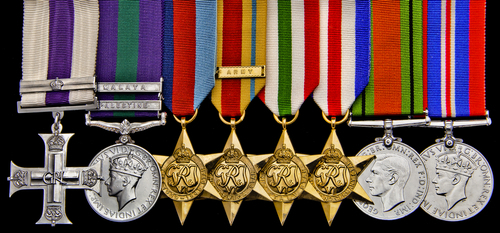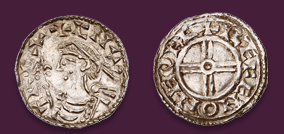
Auction: 13001 - Orders, Decorations, Campaign Medals and Militaria
Lot: 9
A Particularly Fine 1941 ´Desert Rat´s´ M.C., and 1945 North West Europe ´Final Push to Hamburg´ Second Award Bar Group of Eight to Lieutenant-Colonel J.A.N. Crankshaw, 11th Hussars, A Veteran of Almost 5 Years Continuous Fighting, From the Western Desert Through Italy, France, Belgium, Holland and into the Heart of Germany
a) Military Cross, G.VI.R., reverse dated ´1941´, with Second Award Bar, reverse dated ´1945´
b) General Service 1918-62, G.VI.R., two clasps, Palestine, Malaya 2nd clasp loose on riband, as issued (2-Lieut. J.A.N. Crankshaw. 11-H.)
c) 1939-1945 Star
d) Africa Star, with 8th Army Bar
e) Italy Star
f) France and Germany Star
g) Defence and War Medals, lacquered, generally very fine
M.C. London Gazette25.4.1941 Lieutenant John Anthony Norman Crankshaw (77589), Royal Armoured Corps (Hussars)
The Recommendation, dated 18.12.1940, states: ´On December 10th 2/Lieut. Crankshaw reconnoitred the enemy position at Alam El Rimth. He successfully located the Eastern Flank, also a Camp and the accurate position and the numbers of enemy Guns. He then proceeded through the enemy lines in between this position and that at Azzaziya and though under considerable Artillery and A/T Gun fire worked round behind and got further reliable information of enemy dispositions and of the Buq Buq - Barrani Road. He then located another defended camp. His task was rendered most difficult by a bad sand storm and the extremely bad going for Armoured Cars. Later that evening from the only available view point, though under concentrated Artillery fire, he continued to report on 2 Camps and further locate enemy gun positions.
On December 11th he attacked the enemy and captured 119 prisoners.
On December 14th when his Sqn was heavily attacked from the air by 12 fighters all 3 of his cars were hit. His own car was set on fire but he managed to extinguish it though the whole back was ablaze. Both his other two car commanders were wounded and their cars immobile but he quickly made one runner out of the two. He organised the wounded and quite soon had his troop of two cars in some degree capable of further action. 2/Lt. Crankshaw´s personal example of bravery, cool headedness imperturbability and outstanding devotion to duty under extremely severe conditions was an inspiration to his whole Troop and worthy of the highest praise.
2/Lt. Crankshaw has throughout the past 7 months shown outstanding ability and in particular in late September carried out two most excellent reconnaissances, gaining very valuable information of the location of Sofafi and Rabia Camps and the positions of guns and A/T Guns. I recommend most strongly that he be awarded the Military Cross.´
M.C. Second Award Bar London Gazette 2.8.1945 Major (temporary) John Anthony Norman Crankshaw, M.C. (77589), 11th Hussars (Prince Albert´s Own), Royal Armoured Corps (London, S.W.3.)
The Recommendation (originally for an Immediate D.S.O.), dated 12.5.1945, states: ´On 21 Apr 45, Major Crankshaw´s Sqn was ordered to reconnoitre Buxtehude. The place was believed to contain valuable German naval papers. A full scale attack to capture the town was to be put in later when information of the enemy dispositions had been gained. Major Crankshaw disposed his troops to reconnoitre the approaches to the town, from the South, South East, and South West. This owing to the country and enemy opposition proved too difficult, but Major Crankshaw immediately saw there was a chance of getting close to the town from the South and South East. On his own initiative he transferred his main effort there. The approaches were covered by men in the woods with bazookas and also an anti-tank gun. Major Crankshaw got a troop into position to watch the enemy and at the same time passed another troop along a track through the woods to get behind the enemy. This move was entirely successful. The anti-tank gun was knocked out from behind, twenty enemy infantry captured and also a staff car full of bazookas. By this time it was too dark to continue but the following day Major Crankshaw sent his troops down the same roads and the town surrendered without a fight. One Admiral, forty officers and 450 ORs captured. The success of this operation was due to the initiative and bold action taken by Major Crankshaw. His handling of his troops was beyond praise and the capture of the town was due to the successful outflanking of the enemy position.´
Lieutenant-Colonel John Anthony Norman Crankshaw, M.C., born 1918; commissioned Second Lieutenant, 11th Hussars, 25.8.1938, and joined the Regiment in Palestine; the 11th Hussars were stationed in Egypt when Italy declared War on Britain and France, June 1940; in September the Italians invaded Egypt; the 11th Hussars, as part of the 7th Armoured Division, harrassed the Italian advance leading to slow progress; in the middle of September the Italians stopped their advance and decided to consolidate their position by creating a line of fortified camps around Sidi Barrani; the defensive line ran from Maktila to Sofafi; on 10.12.1940 Crankshaw was involved in the early part of the "Battle of the Camps" as part of Operation Compass; the 7th Armoured Division moved to cut off supply routes to Sidi Barrani from the west whilst the remainder of the British forces moved on Sidi Barrani itself; on the 11th December the 7th Armoured Division moved into the Buq Buq area with great success capturing large amounts of troops and guns - Crankshaw´s Squadron captured 119 prisoners; with the expulsion of the Italian forces from Egypt the 7th Armoured Division moved on to be involved in a further series of battles including Bardia, the Capture of Tobruk and Beda Fomm; by February 1941 the Allied forces had advanced approximately 800 kilometres and the Italian Tenth Army had been decimated; Lieutenant 1.1.1941; after a refit in Egypt the 11th Husars returned to the Western Desert to take part in the attempt to lift the siege of Tobruk, May 1941; the 7th Armoured Division were forced out of the line due to suffering heavy casualties and did not return to the front until November, when they were in time to take part in the equally bloody battle at Sidi Rezegh; Temporary Captain 3.7.1942-12.3.1944; Adjutant 5.9.1942-23.2.1943; in 1942 Crankshaw´s regiment were heavily involved with the battle of the First Alamein, Alam Halfa and the British offensive of El Alamein in October; Temporary Major 13.3.1944-31.5.1948; in early 1943 the Division took part in the final push to expel the Axis forces from North Africa, and on the 7th May the 11th Hussars captured Tunis; the 7th Armoured Division were rested for the invasion of Sicily but did land in Italy and took part in the assault across the River Volturno; the Division returned to England in late 1943 for a well earned rest and to re-equip for the Normandy Landings; prior to the Normandy Landings the 11th Hussars transferred to VIII Corps, and served with them throughout the Normandy Campaign including at Villers Bocage and the Battle of Brigade Box (the second week of June 1944); Crankshaw´s regiment took part in Operation Goodwood before returning to the 7th Armoured Division in the first week of August; they were to serve with the 7th Armoured Division for the remainder of the War; fighting at Mont Picon and breaking out of Normandy into Belgium and on into Holland; on the 27th March 1945 the 11th Hussars led the Division across the Rhine; having fought across Germany from the Tuetoberger Wald to the River Weser their final objective was to capture Hamburg; arriving in the outer suburbs by the second week of April the 11th Hussars were often involved in house to house fighting; Crankshaw found himself in the thick of it at Buxtehude on the outskirts of Hamburg (see Recommendation to M.C. Second Award Bar above), 21.4.1945; Hamburg surrendered on the 3rd of May, with the 11th Hussars leading the 7th Armoured Division into the city; Major 25.8.1951; Lieutenant-Colonel 19.10.1958; retired 31.3.1962.
Sold for
£4,500




